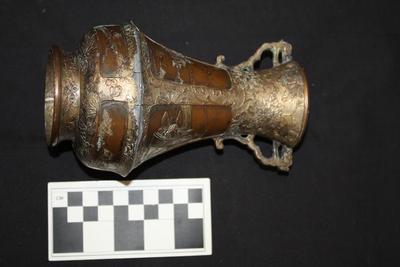E0394: Vessel
Ethnographic
Identifier:
E0394Classification Category:
7:Distribution & Transportation Artifacts ➞ ContainerMarks/Labels:
Used to be a tab that said "Japanese Vase" but not there anymore.Materials:
metal ➔ bronzeDimensions:
10 cm W17 cm H
Provenance of Object:
Based on a past interview with Chee Liang Wee, the provenance of the vase was decided to be Japan based off of the hairstyle of one of the women depicted, the architecture of the fort shown, the low table also depicted, and the style of the headdress of another figure shown (Wee, Liang Chee).Many aspects of the vases design do show some reference to Chinese influence, especially the panels depicting scenes of nature along with the dragon handles, but these are also found in Japanese pieces as well. The dragons, known in Japanese by the term ryu, are originally based off of the Chinese lung dragon (Hall, 20-21). The panels depicting nature, on the other hand, are indicative of both Chinese literati as well as Zen Buddhist painting motifs (Mason, 285-286; Swann 150). Ultimately, it is the observations and evidence presented above that allows us to conclude that the vase most likely comes from Japanese culture.
This object was held in the museum that Luther College started in 1877. This museum eventually grew into the Vesterheim Norwegian-American Museum, and following this, non-Norwegian American ethnographic objects were returned to Luther and accessioned into the college’s Anthropology Collection. Without additional documentation, was likely obtained by the Luther College Museum (later the Norwegian-American Museum) between the late 19th century and early 20th century.

